 EM Paducah Site infrastructure support services contractor Swift & Staley is working with local subcontractor Beltline Electric to complete a tie-in of a new bypass power distribution system into the Tennessee Valley Authority substation.
PADUCAH, Ky. – Roadways, railroads, water and sewage treatment facilities, a bank, a post office, a fire department, and security force — all of this made up EM’s Paducah Site more than 60 years ago.
During the Cold War, the Paducah Gaseous Diffusion Plant (PGDP) site was designed and built to function much like a small city, complete with its own infrastructure. With the Cold War ended, and the uranium-enrichment industry having moved away from gaseous diffusion to more efficient technologies, the site no longer needs the extensive infrastructure once required. Therefore, as EM advances cleanup of the western Kentucky site, it is working to reduce utility costs and energy consumption.
In the decades when PGDP was operational, Paducah maintained four electrical switchyards, which could support up to 3,000 megawatts of power per hour. This is enough energy to power a city as large as Nashville, Tennessee.
 A postcard is shown from the uranium-enrichment era at Paducah, Kentucky. Although the postcard promoted the nearby City of Paducah, the Paducah Gaseous Diffusion Plant’s size and scope — akin to that of a small city — were commensurate with its impact on the region’s economy. The Paducah Site once used as much electricity as a city the size of Nashville, Tennessee.
 |
|
Workers with EM Paducah Site infrastructure support services contractor Swift & Staley finalize completion of a new bypass power distribution system. |
Today, the site’s cleanup mission only uses about 12 megawatts per hour. This reduction in energy requirements provided an opportunity for EM to reduce energy costs and consumption by constructing a new electrical substation and power distribution system, operated by the Tennessee Valley Authority (TVA).
Earlier this year, EM safely took Paducah’s last remaining switchyard offline and transferred electrical loads to the new substation. In order to transfer power from the substation to the plant, EM’s infrastructure support services contractor, Swift & Staley, with its subcontractor Beltline Electric Company, constructed a new power distribution system to connect the new TVA substation into the existing plant feeder systems.
“I am proud of the work being done to reduce the amount of energy and other utilities we consume at the Paducah Site,” Portsmouth/Paducah Project Office Paducah Site Lead Jennifer Woodard said. “The energy savings we garner over the next several years will go a long way in advancing our cleanup mission at Paducah.”
-Contributors: Dylan Nichols, Amanda Scott, Jessica Vasseur
 These photos show the largest of three aging underground structures, the Z-9 crib, before and after stabilization. The 60-foot-long covered trench for liquid waste disposal during past Hanford Site operations was filled nearly to the top with about 4,000 cubic yards of engineered grout to cover residual contamination and stabilize the structure.
RICHLAND, Wash. – EM Richland Operations Office (RL) and contractor Central Plateau Cleanup Company (CPCCo) recently completed actions to stabilize three at-risk underground structures on the Hanford Site’s Central Plateau.
“The project has met the objective of mitigating the release of contamination for an age-related collapse of the three structures,” said Al Farabee, Hanford’s senior technical advisor for the project. “Completion of this project is a significant step forward in our mission to reduce risk to workers and the environment.”
The three structures — the 216-Z-9 crib, 216-Z-2 crib and 241-Z-361 settling tank — are located near the former Plutonium Finishing Plant. All three underground structures received liquid waste during Hanford’s plutonium production operations and contain residual radioactive and chemical contamination.
The cribs are deep, unlined trenches in the soil, covered with wooden or concrete roofs, with pipes running into them for disposal of liquid waste. After waste flowed into the cribs, solids would settle to the bottom and liquids would be absorbed into the soil column over time.
Earlier this year, workers safely completed filling the two largest structures, the Z-9 crib and Z-361 settling tank, with engineered grout.
 |
|
An assembly line of trucks delivers engineered grout to fill underground disposal structures, reducing risk on the Hanford Site’s Central Plateau. |
Engineered grout is poured to fill underground disposal structures on the Central Plateau at the Hanford Site. |
|
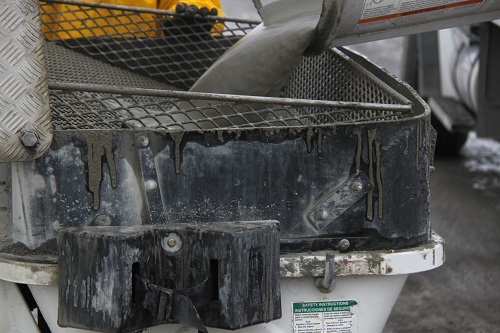 |
For the Z-2 crib, the project team identified additional soil above the crib that was not evident in the drawings or identified during field walk-downs. When this additional soil was considered in the revised risk analysis, it was determined that this thicker layer of soil provides proper protection in the event of a crib collapse.
Routine monitoring will continue to ensure all three structures remain stable in their current configuration.
“I am proud of our team for overcoming many challenges to complete this critical project,” said Bob Nichols, director for CPCCo’s Inner Area End States group. “As Hanford continues to advance this and other elements of its risk reduction mission, the safety of our workforce will continue to be paramount.”
-Contributor: Dieter Bohrmann
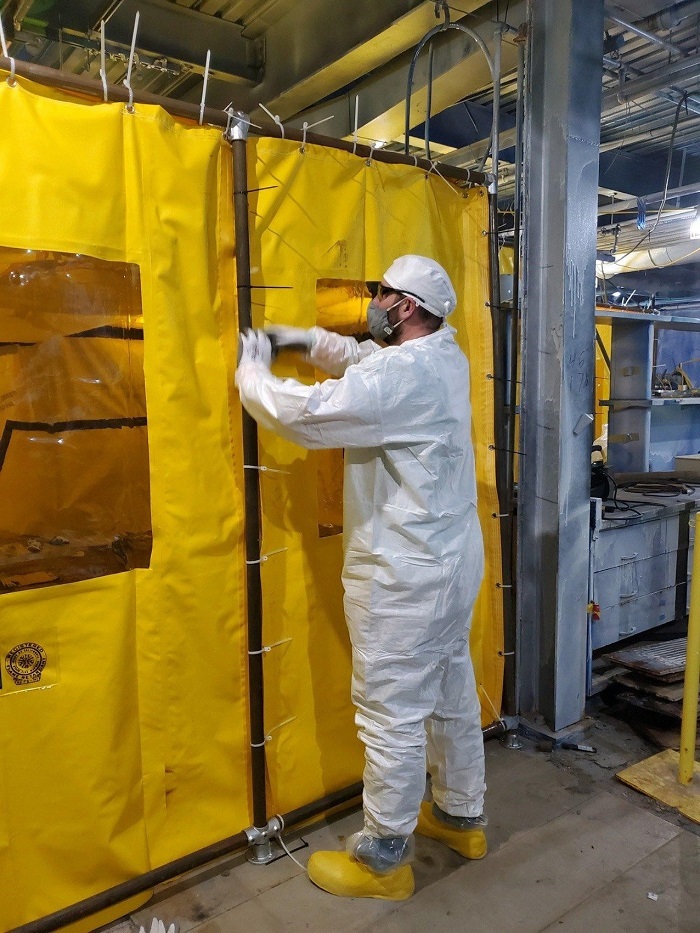 Jim Kuhn, Jr., an employee with CH2M HILL BWXT West Valley, helps set up a protective tent above the Vent Wash Room in the Main Plant Process Building to support ductwork cutting as the site prepares for the future demolition of the facility at the West Valley Demonstration Project.
WEST VALLEY, N.Y. – West Valley Demonstration Project (WVDP) workers are preparing to remove ductwork that carried exhaust from past operations at the Main Plant Process Building as part of deactivation preparations for the facility’s future demolition — among EM’s 2021 priorities.
EM and its prime contractor CH2M HILL BWXT West Valley (CHBWV) recently constructed a containment tent above a room and access door in the building to support cutting a 26-inch-wide duct inside the room.
“The WVDP team’s work was well planned and executed in an effort to maintain safety, including the addition of COVID-19 protocols,” EM WVDP Deputy Federal Project Director Steve Bousquet said.
Known as the Vent Wash Room, the space housed a ventilation "scrubber” that removed airborne particulates resulting from fuel reprocessing operations that ceased in 1972.
Several other areas within the plant — including the product purification and chemical process cells, and a fuel receiving and storage facility — sent exhaust to the room through the ductwork. The exhaust was then directed to a ventilation exhaust cell where it was filtered before being discharged to the plant’s stack.
“This work activity will allow the continued deactivation tasks when we resume complex work activities when it’s safe to do so under COVID-19 protocols,” said Scott Chase, CHBWV facility disposition operations manager.
-Contributor: Joseph Pillittere
 Hanford’s Waste Treatment and Immobilization Plant startup team gives a thumbs up for completing initial testing of equipment and systems, called melter trains, that support huge melters in the plant’s Low-Activity Waste Facility, marking another step toward treating tank waste. The team members include, front row, from left, Kevin Krylowski, Clayton Parent, and Annie Fyfe; back row, from left, Dan Nauts, Bryan Jewell, Casey Downs, and Joseph Kemper.
RICHLAND, Wash. – The EM Hanford Waste Treatment and Immobilization Plant (WTP) team is on track to conduct the next phase of safety testing inside the Low-Activity Waste (LAW) Facility, now that initial testing of its two “melter trains” is complete.
The term melter train refers to systems and custom-made equipment connected to melters that will vitrify, or immobile in glass, millions of gallons of radioactive tank waste. In late March, workers finished testing these systems for feeding waste to the melters, operating the melters, and treating vitrification exhaust.
“Plant staff can now begin the second phase of safety testing of the melter trains, and this moves us closer to heating up the first melter for Direct-Feed Low-Activity Waste (DFLAW) later this year,” said Mat Irwin, Office of River Protection deputy assistant manager for the plant. “These are important steps in plant startup testing and preparing us for a loss-of-power test before we heat up the melter.”
The loss-of-power test will demonstrate the team is able to protect the melter by putting the LAW Facility into safe condition and restoring power before any damage to the melter occurs.
The DFLAW process is a system of interdependent projects and infrastructure improvements, managed and highly integrated as a program, that must operate together to vitrify low-activity waste.
The team is currently checking the primary exhaust, or off-gas, system’s protection features, known as safety instrumented function testing. The testing ensures the built-in secondary safety systems’ hardware and software work together and function correctly.
“Starting this next phase of function testing gets us one step closer to making glass,” said Mark Moyer, plant test lead for Waste Treatment Completion Company, subcontractor to WTP contractor Bechtel National Inc. “It’s a huge accomplishment for our team to get to this phase of testing, and it’s a tribute to all of the engineering, procurement, and construction work that came before.”
Safety instrumented function testing is expected to conclude by October.
The WTP facilities can be viewed using the self-guided Hanford Virtual Tour.
-Contributors: George Rangel, Staci West
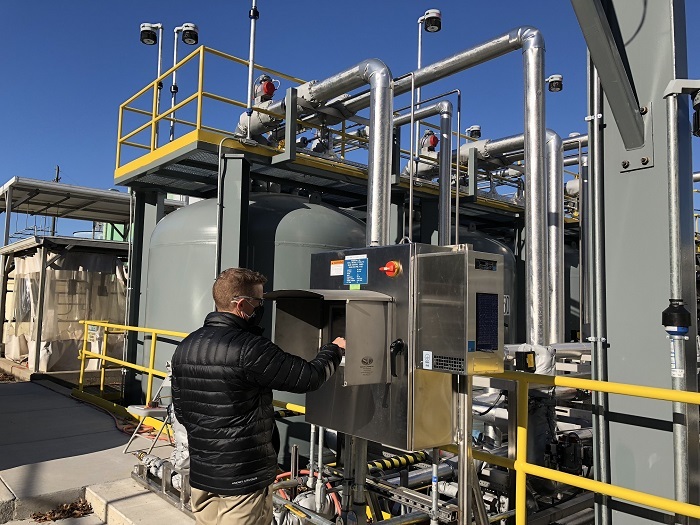 An employee configures a control panel that is part of a modernized zeolite treatment system at the Oak Ridge National Laboratory.
OAK RIDGE, Tenn. – DOE’s Oak Ridge Office of Environmental Management (OREM) recently reduced the cost of treating wastewater, a vital function to EM’s cleanup mission, by consolidating capabilities into a single facility.
The improvements are among EM’s considerable investments in recent years to upgrade and extend the life of aging treatment systems at the Oak Ridge National Laboratory (ORNL).
OREM contractor UCOR completed construction and startup of a new zeolite treatment system that is part of Oak Ridge’s larger Liquid and Gaseous Waste Operations infrastructure. This project consolidates radiological and non-radiological wastewater treatment capability into a single facility that costs less to operate and allows for the deactivation and decommissioning of outdated processing facilities.
“While this wastewater treatment system does not make headlines, it is crucially important to ongoing EM and DOE Office of Science missions in Oak Ridge,” said Nathan Felosi, OREM’s ORNL portfolio federal project director. “EM’s recent investments are improving the system’s operation and reliability and extending the service life of important nuclear mission support functions.”
Installation of the zeolite treatment system is the latest modernization effort funded by a more than $20 million EM investment to upgrade and extend the life of Liquid and Gaseous Waste Operations infrastructure.
The zeolite treatment system is designed to remove cesium and strontium from wastewater. Zeolite, a naturally occurring mineral formed from volcanic ash, strips the contaminants from the wastewater. The system includes five vessels — two dual media filters and three zeolite columns — and dewatering equipment.
Other modernization projects involved replacing deteriorated piping, antiquated equipment, and failing electrical systems.
The Liquid and Gaseous Waste Operations infrastructure consists of numerous interconnected facilities that support crucial waste treatment activities for EM and the Office of Science. Due to its age and deteriorated condition, Building 3544 presented one of the largest risks. The building had served as a radiological wastewater treatment facility for more than four decades, housing the previous zeolite treatment system.
OREM installed the modernized zeolite treatment system at Building 3608, which formerly served as a non-radiological wastewater treatment facility.
By constructing, assembling, and testing the treatment system offsite before delivery, the project team successfully overcame challenges normally associated with on-site construction in the vicinity of an active wastewater treatment facility.
Now that the new treatment process is operational, Building 3544 is awaiting decommissioning in the near future.
-Contributor: Shannon Potter
 Diver John Lehto, right, receives final instructions from Carter Thomas before entering a 300,000-gallon water tank on the Hanford Site to examine and record current conditions and perform routine maintenance. Lehto and Thomas are employees of Hanford Site subcontractor Associated Underwater Services.
RICHLAND, Wash. – EM Richland Operations Office (RL) contractors Central Plateau Cleanup Company (CPCCo) and Hanford Mission Integration Solutions (HMIS) recently teamed up to dive into some inspection and maintenance activities that were anything but routine.
The challenging project involved sending highly-trained divers with specialized equipment into two 300,000-gallon water tanks to inspect conditions, remove sediment and debris, and perform minor repairs.
View this video for sights and sounds from this unique project.
The tanks provide water for a portion of the Hanford Site. The National Fire Protection Association requires the inspections every five years.
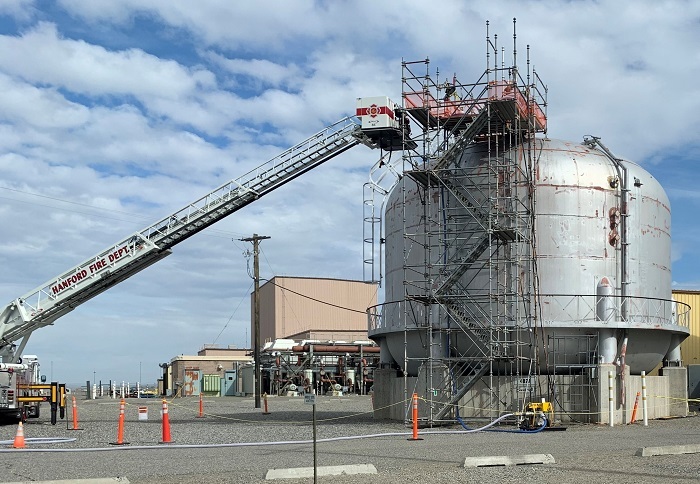 Workers with EM contractor Hanford Mission Integration Solutions installed scaffolding to get divers, support crews, and specialized equipment safely to the top of 50-foot-tall water tanks so that divers could inspect their interiors.
Bryce Young with Hanford Mission Integration Solutions inspects scaffolding prior to divers scaling a large water tank and descending into the water on a ladder to inspect the tank’s interior. The success of the complex inspections involved teams from multiple contractors and crews, reinforcing the value of a collaborative approach.
The joint effort required extensive planning and close coordination among several teams. HMIS workers installed scaffolding to allow the divers and support crews to safely access the entry hatches at the top of the 50-foot-tall tanks. CPCCo managed the dive teams and coordinated the inspections, and the Hanford Fire Department stood ready to provide support in the event of an emergency.
After safety checks, divers climbed down ladders into the water, while workers monitored a video feed from cameras on the divers’ helmets nearby.
“I’m proud of our teams for the excellent organization and clear communications among multiple contractors and crews needed to safely complete this work,” said Mark French, EM project and facilities division director. “The success of complex projects, like this, reinforces the value of our collaborative approach; everyone is working together to accomplish the cleanup mission.”
-Contributors: Dieter Bohrmann, Robin Wojtanik
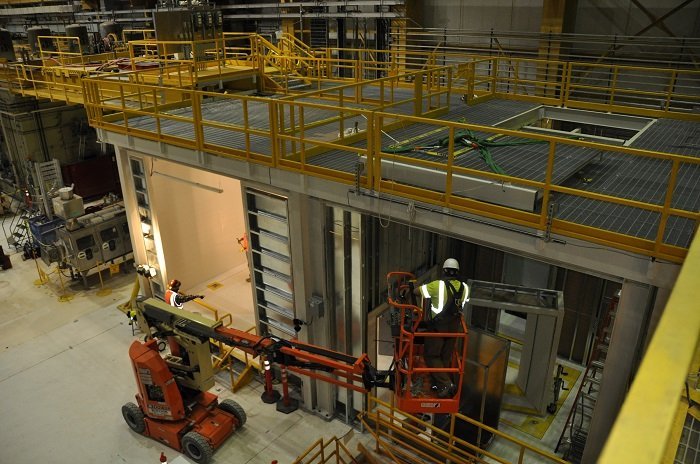 In late 2020, CH2M HILL Plateau Remediation Company completed construction of a full-scale mock-up of a system that will be used to transfer nearly 2,000 radioactive capsules from an underwater basin to safer, dry storage on the Hanford Site.
RICHLAND, Wash. – EM Richland Operations Office (RL) awarded former cleanup contractor CH2M HILL Plateau Remediation Company (CHPRC) more than $6.3 million, or about 78% of the available fee of more than $8.1 million for the first four months of the fiscal year that began Oct. 1, 2020.
EM releases information relating to contractor fee payments — earned by completing work called for in the contracts — to further transparency in its cleanup program.
The Plateau Remediation Contract was transitioned to the Central Plateau Cleanup Company on Jan. 24, ending CHPRC’s contract with EM. CHPRC’s preparation for transition and collaborative relationship with the incoming contractor provided for a smooth transition. According to the award fee determination summary, CHPRC accomplished a number of performance goals for cleanup of the Hanford Site during the evaluation period, including:
- Obtaining approval for the scope, cost, schedule, and start of construction on the Waste Encapsulation Storage Facility Modification Project, which will help prepare the facility to support the transfer of cesium and strontium capsules to dry storage.
- Modifying Integrated Disposal Facility infrastructure and environmental permitting to support the Direct-Feed Low-Activity Waste approach to treat low-activity waste from Hanford’s large underground tanks.
- Treating over 840 million gallons of contaminated groundwater.
- Continuing an effective COVID-19 pandemic response integrated with DOE and other Hanford contractors.
Evaluation of a contractor’s performance is conducted under objective and subjective performance measure categories. In the objective category, CHPRC earned 87% of the available fee, or more than $3.5 million. In the subjective category, the contractor earned nearly 69% of the available fee, or more than $2.8 million.
Areas for CHPRC improvement included quality and timeliness of facility safety documentation and performance of required audits.
View CHPRC fee determination scorecards here, including the latest scorecard.
|